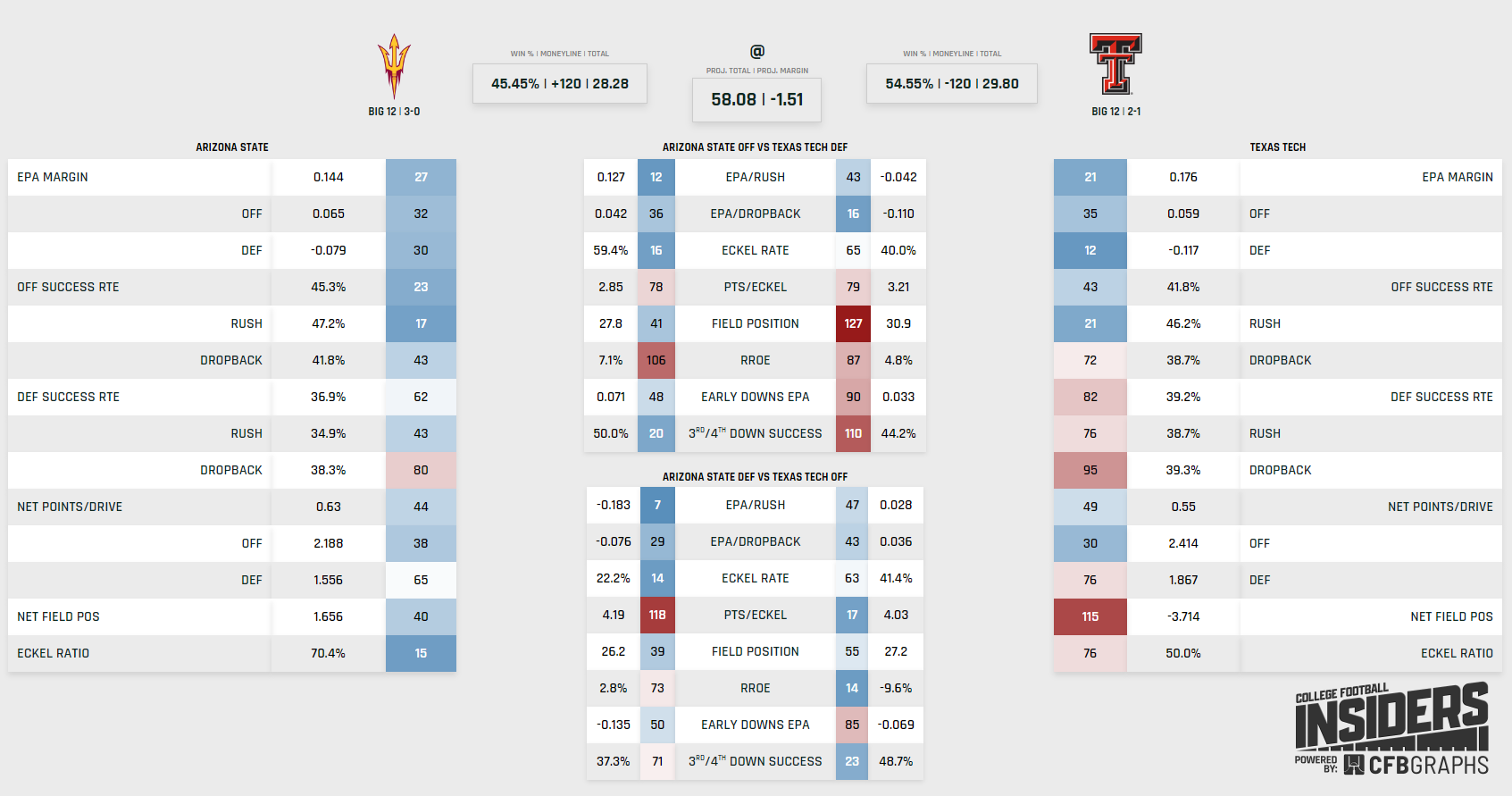A Little Play-calling Analysis and Texas Tech Preview
Advanced stats show what ASU does often, what they do well, and what they need to improve on moving forward.
So ESPN didn’t do play-by-play data for the ASU/Texas State game, so there aren’t any advanced stats to look at. However, Bud Davis (@JBudDavis on X.com), was doing some play-calling analyses and I asked him to do ASU, and he obliged, so we’re going to take a look at that.
First, let’s take a look at the stuff we probably already knew that the analysis confirms:
ASU’s offense is pretty run-heavy. Designed runs are called 8% more than the average.
ASU targets RBs in the passing game more than the average, and it is the most effective part of the offense, with a success rate of 57% (really good) and an EPA/play of .52 (even better).
ASU does not throw downfield much (7% less than the average), and when they do, they have not been particularly successful (29% success rate).
Now lets look at things that are more interesting:
ASU has utilized RPOs infrequently, 14% less than the average. Given Kenny Dillingham’s background, and Sam Leavitt’s athleticism, I expected more. They have been successful, with a 50% success rate and an EPA/play of .2, so maybe now that conference play is starting, the playbook will be opened up and they’ll become a bigger part of the arsenal.
ASU has a clear favorite personnel package (11 personnel), and uses it more heavily than other teams do. Since this package is used a large majority of the time, it’s success rate and EPA/play (43% and .02) nearly mirror the offense’s overall numbers (46% and .11). Since ASU is so deep at RB, there was some talk that 21 personnel would be frequently used, but that hasn’t been the case - the package has been used less than 1% of the time. It’s possible that use will go up now that Raleek Brown is healthy, since he’s the most hybrid of the RBs.
Despite being a run-heavy offense, ASU has faced heavy box (more than 6 men) only 24% of the time, 12% less than the average. ASU has been pretty successful against a stacked box, showing that Dillingham and Marcus Arroyo have been pretty good at scheming against it, which has kept the defenses they’ve faced honest.
Related to 2 & 3, ASU has rarely faced middle-of-the-field-open (MOFO) situations. MOFO and MOFC (middle-of-the-field-closed) refer to the positioning of safeties - MOFO is generally associated with two high safeties, while MOFC indicates one high safety. This would seem to contradict bullet 3, as a single-high safety often indicates a stacked box. I think what’s going on is that teams are bringing a safety closer to the line of scrimmage, but ASU’s 11 personnel package is keeping them from coming all the way into the box. This means that there are opportunities for ASU to have success throwing the ball downfield, and they need to get better at taking advantage of those.
ASU has not been effective targeting the TEs so far. Chamon Metayer has made some plays, but a lot of passes to TEs have gone for short gains, and ASU’s one interception so far this season was on a throw to a TE, which makes a difference early in the season when the sample size is still pretty small.
Scrambles and designed QB runs have been a very effective part of ASU’s offense. Designed QB runs have the highest success rate (62%) of any type of play, and also produce a good EPA/play (.22).
How much will these trends hold? I think ASU will continue to be pretty run-heavy moving forward, but not to the same extent. Same with the targeting of RBs in the passing game. ASU will improve throwing the ball downfield as Leavitt gets more comfortable (we saw a little of that in the Texas State game) and that will necessarily result in the WRs and TEs getting more involved. I think we’ll see more RPOs as well, which will also increase the TEs’ and WRs’ targets. As all this happens, ASU will see more MOFO situations, and we’ll see the success rate and EPA/play of RB runs go up. However, if ASU does not get better at throwing the ball downfield, teams will stack the box more and more, and the offense will stagnate.
Week 4 Big 12 Power Rankings
Again, this is purely resume-based, and not a prediction of how they’ll finish in the conference standings, nor an indication of who the best teams are.
Kansas State - 3-0 with a dominating win over a ranked opponent (even though I think that opponent was overrated).
Iowa State - they were off, but their 2-0 record includes a road win over a ranked opponent.
Oklahoma State - They hammered Tulsa on the road, haven’t really played anyone, but have looked quite good.
UCF - 3-0 with a road conference win.
ASU - First two wins don’t look as good as they once did, but they’re 3-0 with a road win over a good g5 team.
Utah - Their resume at this point is very similar to ASU’s.
BYU - 3-0 and has looked decent.
Baylor - 2-1, and only loss was to a good team, and they kept it respectable.
TCU - 2-1, hasn’t looked great, and has a home conference loss.
Texas Tech - 2-1, looked good on Saturday for the first time.
UofA - 2-1, has not looked good at all. Got hammered by K-State.
Colorado - 2-1, also hasn’t looked like a good team.
Cincinnati - 2-1, hasn’t looked good, either.
Kansas - 1-2, most disappointing Big 12 team so far. Lost to a g5 team at home.
Houston - 1-2, probably the worst team in the conference.
West Virginia - 1-2, blew a big lead at Pitt.
3 weeks in and a lot of the weirdness from the early rankings is gone. Utah is probably the most out of place, as I think they’re one of the top 3 teams in the conference, but they just haven’t had a chance to accomplish much yet. That will change this week.
ASU vs Texas Tech Advanced Stats Preview
From the guys at College Football Insiders:
College Football Insiders have ASU as a slight underdog (1.5 pts and 45% chance of victory), slight enough that if the game were played in Tempe, ASU would be favored. Projected score is 30-28. For comparison, SP+ has ASU as a 4-pt underdog, while Vegas has them as 3-pt underdogs.
ASU seems to have an advantage when they have the ball - Texas Tech has a DEF success rate of 39.2%, 82nd in FBS, while ASU has a high OFF success rate (45.3%, 23rd in FBS) and high EPA/play numbers. Tech’s high defensive EPA/play rank, when combined with their low DEF success rate rank, indicates that they do create turnovers (turnovers are high EPA plays, but only count as 1 successful play in success rate). Tech is about average in letting teams get inside their 40, and is below average at stopping teams once they do (ECKEL rate and PTS/ECKEL). ASU does really well at extending drives into opponents’ territory (16th in FBS), but has struggled to finish those drives (78th).
Where it gets interesting is when Texas Tech has the ball. Their EPA/play numbers are quite good, and rank higher than their success rate does, indicating that they generate a high number of big plays, especially in the passing game. Their run game is more efficient, but less explosive. ASU’s defensive passing numbers are similar, with EPA ranks significantly higher than that of their success rate. We know that ASU is one of the best teams in the nation at creating turnovers. The defense has been more efficient at stopping the run, mirroring how Tech’s offense has performed. Tech’s average starting field position is horrid (115th in FBS), indicating a combination of turnovers and a bad punting game. In contrast, ASU’s net field position has been quite good (40th).
If ASU doesn’t give up big passing plays, and limits the efficiency of Tech’s run game (this is a strength vs strength), I don’t think Tech will be able to sustain drives by being patient in the passing game, and the likelihood of them turning the ball over goes up. On the other side of the ball, ASU will probably be able to move up and down the field on Tech, and the key will be finishing drives. If they do all that, ASU wins.
Please let me know what you think in the comments, and subscribe and share. Thanks, everyone.





